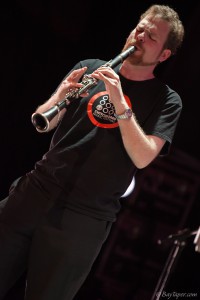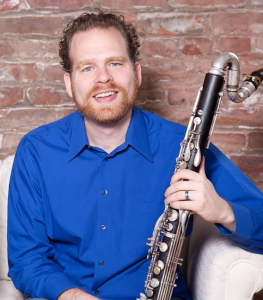Jonathan Russell (b. 1979) creates music by turns tender and fierce, playful and profound, raw and refined, propulsive and still. In his work, he seeks to embody and express the full range of human experience in a way that speaks directly to people’s hearts, minds, and bodies.
While he composes for all sorts of instruments, the extraordinary sound and spirit of the bass clarinet in particular is a driving force behind much of his work. His numerous compositions for bass clarinet(s) include solo works, sonatas, concertos, duets, trios, quartets, chamber works, and large bass clarinet ensembles. He was a longtime member of the Edmund Welles bass clarinet quartet, which channeled the ecstatic power of heavy metal through the deep acoustical resonances of four bass clarinets. He is a member, with Jeff Anderle, of the Sqwonk bass clarinet duo, which for the past 15 years has devoted itself to creating a new repertoire of expressive, vital, joyous music for two bass clarinets. He is also the founder and leader of Improbable Beasts, a professional 15-member bass clarinet ensemble in the Boston area. This group represents the culmination of Jonathan’s bass clarinet journey, allowing him to fully realize the richly-textured, harmonious, ferocious music of his dreams.
Jonathan also has a significant body of work for “bass clarinet-adjacent” instruments such as Bb clarinets, saxophones, and other wind instruments. He loves the deeply human, physical quality of breath-produced sound, the wide spectrum of colors winds can produce, and the vast range of musical genres they can tap into, from Mahlerian bombast to jazz, klezmer, Balkan, Dixieland, funk, Latin, and beyond. His many wind-based compositions include works for solo saxophone, clarinet duet and trio, clarinet choir, saxophone choir, reed quintet, wind/brass octet, wind band, and clarinet and saxophone concertos. His wind works have been commissioned and performed by ensembles such as the Eastman Saxophone Project, Eastman Wind Ensemble, Imani Winds, Splinter Reeds, Nomad Session, Égide Duo, and Paradise Winds. Jonathan also writes for more conventional ensembles: orchestras, string quartets, choirs, mixed chamber ensembles, solo piano, etc., and these works have been performed by groups such as the San Francisco Symphony, Roomful of Teeth, So Percussion, and JACK quartet, among many others.
Arranging music of the past for implausible combinations of modern instruments is another one of Jonathan’s favorite activities. Imani Winds commissioned his woodwind quintet arrangements of The Rite of Spring and Scheherazade, which the ensemble has performed dozens of times throughout the United States and internationally. Other examples include Bach’s Toccata and Fugue in D Minor and Dear Theodosia from Hamilton for two bass clarinets; The Rite of Spring for electric guitar, percussion, and two bass clarinets; Ligeti’s harpsichord work Hungarian Rock for reed quintet; and numerous works, from choral pieces to string quartets to 11th-century chant, for bass clarinet ensemble.
Many of Jonathan’s projects have involved collaborations with or responses to other artists. He is fascinated by the similarities and vast differences between music and these other art forms, and by the challenges of “translating” from one to the other. He has served as music director for seven evening-length dance productions with San-Francisco-based choreographers Janice Garrett and Charles Moulton (Garrett + Moulton Productions), working closely with them to select, edit, arrange, and compose music for the productions, and then to organize, play in, and lead an ensemble of live musicians. In 2017, he wrote a work for the ZOFO piano duo to accompany a work of street art by Stormie Mills that he discovered while living in east London (and which has since been painted over). In 2019, he composed a piece to accompany a work by master woodcarver David Esterly. That same year he composed music for the Rochester-based ensemble fivebyfive to accompany Judith Schaechter’s stunning stained glass work The Battle of Carnival and Lent. In 2020 he wrote his first film score for the silent film Demons Before Breakfast, which premiered at the 2020 “Sound of Silent Film Festival” in Chicago.
As a performer, Jonathan seeks to explore and master the entire range of what his instruments can do, from the refinement and precision of the classical tradition, to the heavy grooves of metal, to the fiery wails of klezmer. He appears frequently with the Sqwonk bass clarinet duo, the Improbable Beasts bass clarinet ensemble, as a freelancer in the Boston area, and as a clarinet and bass clarinet soloist. He is also a sought-after guest clinician in composition, clarinet/bass clarinet, and creative/unusual musical career paths. He has appeared in this capacity throughout the United States, as well as in Mexico, Germany, and New Zealand. In 2021, he was one of ten bass clarinetists from around the world selected to produce a series of instructional videos and give a masterclass for the online Digital Bass Clarinet Academy. He serves on the faculty for the annual San Francisco Conservatory Bass Clarinet Intensive, a joyous week-long clinic on all aspects of bass clarinet performance.
An active member of the clarinet and bass clarinet communities, Jonathan is a regularly featured performer at the International Clarinet Association’s annual ClarinetFest, serves on the ICA’s New Music Committee, and is on the artistic team for the biennial Low Clarinet Fest. A card-carrying music theory nerd, Jonathan’s doctoral dissertation is a 400+ page harmonic analysis of the entire Rite of Spring. He holds degrees from Harvard University (B.A.), San Francisco Conservatory of Music (M.M.), and Princeton University (Ph.D.), and has taught at Harvard, San Francisco Conservatory, and MIT. His primary composition teachers have included Paul Lansky, Dmitri Tymoczko, Dan Trueman, Barbara White, Steve Mackey, Dan Becker, Elinor Armer, Eric Sawyer, John Stewart, and Eric Ewazen. His clarinet teachers have included Janet Greene, Alan Kay, and Jo-Ann Sternberg.
When not making music, Jonathan loves exploring cities, bicycling, and improv comedy (both watching it and feebly attempting to do it himself). He lives in Cambridge, MA.
PRESS
The composition by American composer Jonathan Russell, inspired by Stormie Mill’s street art painting, was my personal favourite of the night. The dynamics and movement of the [ZOFO piano] duo during this piece resembled the title of the painting – Untitled Skeleton. Zimmermann stood behind and leant over Nakagoshi throughout the piece, and on the piano followed him from bass all the way to treble, awkwardly playing a few scattered notes. At the end, she finished her last note and still standing, collapsed onto him, as if they were both dead. The composer explored the idea of someone “trying to make his way from the underworld up to East London’s hip, busy streets”, according to the program, but his other self was sabotaging his attempt to rise up, which was represented both visually and musically by ZOFO.
A different kind of concerto style was heard from Jonathan Russell’s Concerto for Bass Clarinet, performed by the orchestra in a world premiere….Mr. Russell emphasized all the bass clarinet’s unique musical effects, including the instrument’s “altissimo” passages and the use of “throat harmonics”… The concerto proved to be an appealing work to hear, often with a melancholy reminiscence of Samuel Barber’s orchestral works. Mr. Russell moved easily through all the registers of the instrument, incorporating funk and jazz styles in long melodic lines….With an extended cadenza that was more of a meditation than a standard 19th-century cadenza, this work succeeded in introducing the audience to the full capabilities of a unique instrument.
Jonathan Russellʼs Sonata for Bass Clarinet and Piano was a jazzy crowd pleaser. In three continuous sections, it began with an ostinato bass in the piano supporting whimsical clarinet riffs that gleamed with wit in Mr. Anderleʼs reading, so spontaneous that it could almost have been taken for improvisation. The center section of the Sonata was a tender ballad that made extensive use of the instrumentʼs saxophone-like upper range. The finale was lively, with a slap note-happy clarinet often accompanying the piano.
The Debussy [Premiere Rhapsodie] impressively well-melded the soloist and the orchestra. This performance gave increasing energy, leading to a smashingly tangy conclusion from a lurking opening. Russell is a real virtuoso with true command over his instrument’s range of expression….
Jonathan Russell’s Twelve Bean Groove Machine was a toe-tapping minimalistic affair where popping riffs mingled into a polyrhythmic collage…
Also worth mentioning is Jonathan Russell…who wrote a piece called Twelve Bean Groove Machine for twelve players. It was excellent fun, with great sounds and textures popping out….a special shout-out is in order to both Russell for writing, and Michael Williams for playing an incredibly virtuosic, rocking, and musical flute solo in the middle of the piece.
Jonathan Russell’s String Quartet…uses that traditional ensemble for music influenced by the rhythms and harmonies of modern progressive rock. The piece had elements of minimalism, but not the mercilessly repetitive kind. Alongside the idiomatic minimalist gestures, things such as dramatic twists and turns, intricate phased rhythms, and a poignant cello solo to fade out at the end kept the piece engaging and unique.
…the [Living Earth Show] duo then performed the world premiere of Jonathan Russell’s “Repetitive Stress.” After a crack about how the piece was repetitive and stressful for the performers (and the audience too…) the duo launched into what my neighbor called “guy music,” a fantastically distorted perpetual motion of awesome.
Jonathan Russell’s Repetitive Stress and Damon Waitkus’ North Pacific Garbage Patch were more-raucous affairs. Russell’s work called for [guitarist Travis] Andrews to exhibit a highly contemporary form of virtuosity: skillful use of sampling software to create minimalistic loops that served as background for [percussionist Andrew] Meyerson’s energetically performed and rock-influenced percussion part….Both pieces gave the audience a wild and most enjoyable ride.
The gentle introspection of Jonathan Russell’s …in the fir trees: fireflies, with its slow and quiet rising lines, offered a wonderful contrast to the rhythmic intensity and harmonic crunchiness of David Biedenbender’s Surface Tension.
Garrett and Moulton work well together; they also choose excellent collaborators. Foremost among them was a group of eight top-flight musicians who, under the guidance of Jonathan Russell, played one of the most deliciously appropriate dance scores that has been heard in these parts in a long time….
The program continued with the Sqwonk Bass Clarinet Duo presenting a world premiere of the wind ensemble arrangement of Sqwonk member Jonathan Russell’s Bass Clarinet Double Concerto. It is a testament to Russell’s writing and the assertive playing of the duo that this work was the most successful on the program.
The recital concluded with the bass clarinet duo Sqwonk (Jeff Anderle and Jonathan Russell) performing Ryan Brown’s Knee Gas (On) and Russell’s own arrangement of J.S. Bach’s Toccata and Fugue in D Minor, BWV 565. Not only did the duo play with impeccable attention to intonation in both pieces, but they also were able to transform their timbre to sound like a real organ during the Bach arrangement.
With their second album, Black, [Sqwonk] have proven that this reputation is well-deserved. Jeff Anderle and Jon Russell make use of the full range of technical and expressive opportunities afforded by the bass clarinet, and the result pushes the envelope of what bass clarinet music can be.…Anderle and Russell’s mastery of their instruments is evident in everything from the frantic and technical KNEE GAS (ON) to the mournful, lyrical lines of Sojourn of the Face. At times the ensemble is producing so many colors that it is easy to forget that there are only two performers, and at other times the blend is so effective that it is difficult to believe there could be more than one. The duo’s repertoire consistently demands perfect production of complicated interwoven lines, acrobatic leaps, and sensitive lyricism in difficult registers; suffice it to say that Anderle and Russell rise to meet the challenge in every instance.…Black is an excellent product of a fast rising star….It deserves a place in the collection of any bass clarinet enthusiast or fan of the styles from which Sqwonk draws influence.
…the high point was the interesting arrangement of the Rite of Spring, by Igor Stravinsky, that required a lot of the group. True, the adaptation done by Jonathan Russell is more highlights than an actual transcription, but the end result is magnificent.
The arrangement [of The Rite of Spring] was by Jon Russell….Even at 20 minutes, it pared down Stravinsky’s 35-minute score substantially, but it was ingenious, implying much of Stravinsky’s orchestral palette in just five parts — Mariam Adam’s clarinet was a fine stand-in for trumpet, for example, and you could just about hear the timpani. Russell also somehow implied the harmonic density of the original with fewer voices than you’d think possible.
A previously announced quintet by Harbison was replaced by Jonathan Russell’s arrangement of Stravinsky’s “Rite of Spring.” The announcement brought both gasps and chuckles from the audience. It turned out to be a real treat to watch and hear up close some of the best moments of the famous score, namely the innovative woodwind writing. It was also arresting to hear the familiar passages for churning strings showing up in other instrumental timbers.
[The Radius Ensemble] opened with an arrangement (2010) by clarinetist and composer Jonathan Russell of Stravinsky’s Le Sacre du Printemps…for wind quintet….The result was amazing. The driving rhythms (helped by the outstanding performance of Gregory Newton on bassoon), the primal harmonies, and the sometimes brutal sound, were all there….The sound was not as loud as I heard it in the Berlin Staatsoper, but the piece and the performance were grippingly gutsy and seemed, if anything, way too short.
The time had come to hear Jonathan Russell’s arrangement for the Imani Winds of Stravinsky’s The Rite of Spring….This is a masterful arrangement and an astounding performance. For those of us familiar with this work, we’d wait for sections that we simply could not imagine being played by just five wind players and sounding satisfying. In each instance, the clarity was revelatory and the rhythmic and harmonic completeness was a musical miracle. A mid-concert standing ovation ensued.
Imani Winds…impressed the sox off a good-sized audience with their ear-boggling performance of Stravinsky’s The Rite of Spring in an arrangement by Jonathan Russell….Very little of the essence of the piece went missing.
Another highlight of the afternoon was Imani’s masterful shredding of Stravinsky’s Rite of Spring in Jonathan Russell’s 2010 arrangement for wind quintet….It was like hearing the Rite again for the first time and left us craving to witness a contemporary dance performance to this arrangement.
The Imani players poured all that virtuosity into a reed-crunching, physical account of [Jonathan Russell’s arrangement of] Stravinsky’s “The Rite of Spring.” What might have been a novelty – five winds imitating an orchestra of over 100 players – radiated authenticity in the Imani account. It was dance music, and ritual music – and it never lost momentum for a second.
The “meat and potatoes and gravy of the concert” came next, as introduced by Diaz: Igor Stravinsky’s The Rite of Spring, arranged for wind quintet by Jonathan Russell. This twenty-minute reduction was true to the original orchestration, with masterfully performed renditions of the iconic solo bassoon, clarinet, and oboe lines in the opening movement. So much sound came out of these five players that it was at times hard to believe that they were not a full orchestra!



